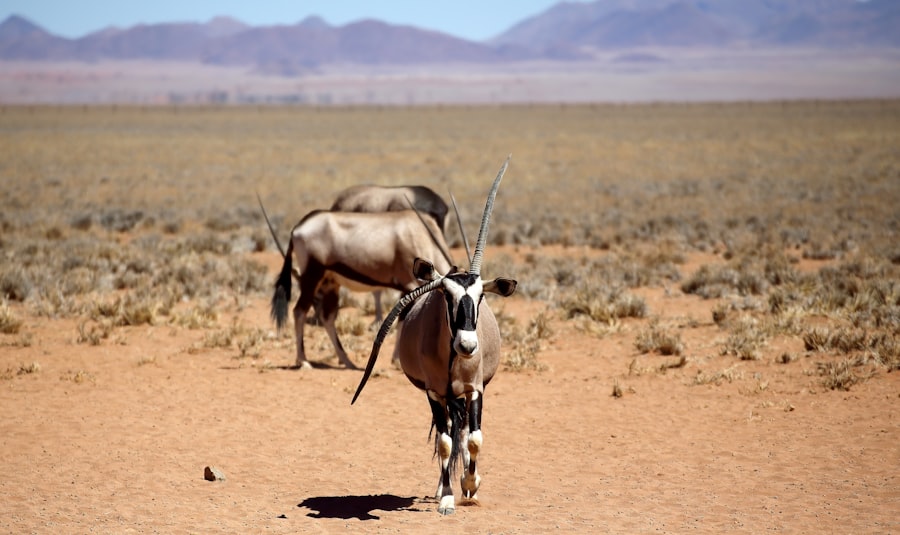Real-time continental deformation refers to the ongoing changes in the Earth’s crust that occur due to various geological processes. These changes can be subtle or dramatic, depending on the forces at play. The study of continental deformation is crucial for understanding the dynamic nature of the Earth’s surface, as it provides insights into the processes that shape landscapes, influence ecosystems, and affect human activities.
As technology advances, scientists are increasingly able to monitor these deformations in real-time, allowing for a more comprehensive understanding of geological phenomena. The significance of real-time continental deformation extends beyond academic interest; it has practical implications for disaster preparedness, urban planning, and environmental management. By tracking the movements of tectonic plates and other geological features, researchers can better predict natural disasters such as earthquakes and landslides.
This knowledge is vital for safeguarding communities and infrastructure, making real-time monitoring an essential component of modern geology.
Key Takeaways
- Real-time continental deformation refers to the continuous and dynamic changes in the Earth’s crust that occur over short periods of time.
- Plate tectonics play a crucial role in real-time continental deformation, as the movement of tectonic plates leads to various geological phenomena such as earthquakes and volcanic activity.
- Monitoring and measuring techniques such as GPS, satellite imagery, and ground-based sensors are essential for understanding and predicting real-time continental deformation.
- Real-time continental deformation can have significant impacts on the Earth’s surface, including the formation of mountains, valleys, and other landforms, as well as the occurrence of natural disasters.
- Advances in technology have greatly improved our ability to monitor and study real-time continental deformation, leading to a better understanding of geological processes and their implications for the future.
Understanding the Dynamic Nature of Continental Deformation
Continental deformation is a complex process influenced by various factors, including tectonic forces, volcanic activity, and sedimentation. The Earth’s lithosphere is not a static entity; rather, it is a dynamic system characterized by constant movement and change. This movement can occur over short timescales, such as during an earthquake, or over long periods, as seen in the gradual uplift of mountain ranges.
Understanding these processes requires a multidisciplinary approach that incorporates geology, geophysics, and environmental science. The dynamic nature of continental deformation also means that it can have far-reaching effects on ecosystems and human societies. For instance, the uplift of land can create new habitats for flora and fauna, while subsidence can lead to flooding in coastal areas.
Additionally, the shifting of tectonic plates can alter river courses and affect sediment transport, further influencing the landscape. By studying these changes in real-time, scientists can gain valuable insights into how the Earth’s surface evolves and how these changes impact life on our planet.
The Role of Plate Tectonics in Real-Time Continental Deformation

Plate tectonics is a fundamental concept in geology that explains the movement of the Earth’s lithospheric plates. These plates float on the semi-fluid asthenosphere beneath them and interact at their boundaries, leading to various geological phenomena. The movement of these plates is a primary driver of continental deformation, resulting in earthquakes, volcanic eruptions, and mountain building.
Understanding plate tectonics is essential for interpreting real-time data on continental deformation. The interactions between tectonic plates can be categorized into three main types: convergent, divergent, and transform boundaries. At convergent boundaries, plates collide, leading to the formation of mountain ranges and deep ocean trenches.
Divergent boundaries occur where plates move apart, creating new crust as magma rises to the surface. Transform boundaries involve lateral sliding of plates against each other, often resulting in significant seismic activity. By monitoring these interactions in real-time, scientists can better predict geological events and understand the underlying mechanisms driving continental deformation.
Monitoring and Measuring Continental Deformation in Real-Time
| Location | Deformation Measurement | Time Interval |
|---|---|---|
| California | GPS stations | Real-time |
| Japan | InSAR (Interferometric Synthetic Aperture Radar) | Continuous |
| Italy | GNSS (Global Navigation Satellite System) | Hourly |
The advent of advanced technology has revolutionized the way scientists monitor and measure continental deformation. Techniques such as Global Positioning System (GPS) technology, InSAR (Interferometric Synthetic Aperture Radar), and strain gauges allow for precise measurements of ground movement. These tools enable researchers to capture data on a range of scales, from local shifts in a specific area to broader regional movements.
Real-time monitoring systems are increasingly being deployed in areas prone to seismic activity. For example, networks of GPS stations are strategically placed along fault lines to provide continuous data on ground displacement. This information is invaluable for understanding the buildup of stress along faults and predicting potential earthquakes.
Additionally, satellite-based technologies like InSAR can detect minute changes in land elevation over time, offering insights into subsidence and uplift processes that may not be visible through traditional methods.
Impacts of Real-Time Continental Deformation on Earth’s Surface
The impacts of real-time continental deformation on the Earth’s surface are profound and multifaceted. As tectonic plates shift and interact, they can lead to significant changes in topography, such as the formation of mountains or valleys. These alterations not only reshape landscapes but also influence local climates and ecosystems.
For instance, mountain ranges can act as barriers to prevailing winds, affecting precipitation patterns on either side. Moreover, real-time continental deformation can have direct consequences for human infrastructure. Urban areas situated near fault lines are particularly vulnerable to damage from earthquakes and related phenomena.
Buildings, roads, and bridges may suffer structural damage or even collapse if they are not designed to withstand seismic forces. Understanding the patterns of continental deformation allows urban planners and engineers to develop more resilient structures and implement effective disaster preparedness strategies.
Real-Time Continental Deformation and Natural Disasters

Natural disasters such as earthquakes, landslides, and volcanic eruptions are often linked to continental deformation processes. The ability to monitor these changes in real-time is crucial for mitigating risks associated with such events.
In addition to earthquakes, real-time monitoring can also help predict volcanic eruptions by tracking ground deformation associated with magma movement beneath the surface. Changes in land elevation or gas emissions can indicate that an eruption is imminent. By analyzing these signals in real-time, scientists can issue timely warnings to nearby populations, potentially saving lives and reducing property damage.
Advances in Technology for Real-Time Continental Deformation Monitoring
Technological advancements have significantly enhanced the capabilities of scientists to monitor continental deformation in real-time. Innovations in satellite technology have made it possible to gather data from remote locations with unprecedented accuracy. For instance, satellites equipped with radar systems can measure ground displacement with millimeter precision over large areas.
Additionally, machine learning algorithms are increasingly being employed to analyze vast datasets generated by monitoring systems. These algorithms can identify patterns and anomalies that may indicate impending geological events. By integrating data from various sources—such as GPS stations, satellite imagery, and geological surveys—researchers can create comprehensive models that improve understanding of continental deformation dynamics.
The Importance of Real-Time Continental Deformation Research
Research into real-time continental deformation is vital for several reasons. Firstly, it enhances scientific understanding of Earth’s geological processes and contributes to fundamental knowledge about plate tectonics and related phenomena. This research also has practical applications in disaster risk reduction and urban planning.
Furthermore, as populations grow and urban areas expand into geologically active regions, understanding continental deformation becomes increasingly important for public safety. By investing in research and monitoring systems, governments and organizations can better prepare for natural disasters and implement effective response strategies when they occur.
Real-Time Continental Deformation and Climate Change
The relationship between real-time continental deformation and climate change is an emerging area of research that warrants attention. As global temperatures rise due to climate change, melting glaciers and ice sheets contribute to changes in land elevation through processes such as isostatic rebound—where land previously compressed by ice begins to rise as the ice melts. Additionally, climate change can exacerbate certain geological processes that lead to continental deformation.
For example, increased rainfall may trigger landslides or erosion in vulnerable areas. Understanding these interactions is crucial for developing comprehensive strategies to address both climate change impacts and geological hazards.
Future Implications and Applications of Real-Time Continental Deformation Research
The future implications of real-time continental deformation research are vast and varied. As technology continues to evolve, researchers will likely develop even more sophisticated monitoring systems capable of providing real-time data with greater accuracy and detail. This could lead to improved predictive models for natural disasters and enhanced understanding of geological processes.
Moreover, interdisciplinary collaboration will be essential for maximizing the benefits of this research. By integrating knowledge from geology, environmental science, urban planning, and disaster management, stakeholders can develop holistic approaches to address the challenges posed by continental deformation in a changing world.
The Significance of Real-Time Continental Deformation in Geological Studies
In conclusion, real-time continental deformation is a critical area of study that offers valuable insights into the dynamic processes shaping the Earth’s surface. The ability to monitor these changes in real-time has significant implications for disaster preparedness, urban planning, and environmental management. As technology advances and research continues to evolve, the importance of understanding continental deformation will only grow.
By recognizing the interconnectedness of geological processes with human activities and climate change, researchers can contribute to more resilient societies capable of adapting to an ever-changing planet. The significance of real-time continental deformation research extends beyond academic inquiry; it plays a vital role in safeguarding lives and preserving ecosystems for future generations.
In recent years, the study of continental deformation in real time has gained significant attention, as it provides crucial insights into the dynamic processes shaping our planet’s surface. A related article on this topic can be found on Freaky Science, which delves into the latest advancements and methodologies used to monitor and analyze these geological changes. For more detailed information, you can read the full article by visiting Freaky Science.
WATCH THIS! The Earth is Trying to Swallow North America: The Unstoppable Geological Disaster
FAQs
What is continental deformation?
Continental deformation refers to the process by which the Earth’s continents change shape and size over time due to tectonic forces such as plate movement, folding, faulting, and volcanic activity.
How does continental deformation occur in real time?
Continental deformation occurs in real time due to the slow movement of tectonic plates, which can cause the continents to shift, collide, or separate. This process can be observed and measured using advanced geodetic techniques such as GPS and satellite imagery.
What are the main causes of continental deformation?
The main causes of continental deformation are tectonic forces, including plate tectonics, which result from the movement and interaction of the Earth’s lithospheric plates. Other factors such as volcanic activity, erosion, and sedimentation can also contribute to continental deformation.
What are the implications of continental deformation?
Continental deformation can have significant implications for geological hazards, such as earthquakes, volcanic eruptions, and tsunamis. It also plays a crucial role in shaping the Earth’s surface and influencing the distribution of natural resources.
How do scientists study continental deformation in real time?
Scientists study continental deformation in real time using a variety of techniques, including GPS measurements, satellite radar interferometry, and ground-based geodetic surveys. These methods allow researchers to monitor and analyze the movement and deformation of the Earth’s crust over time.
